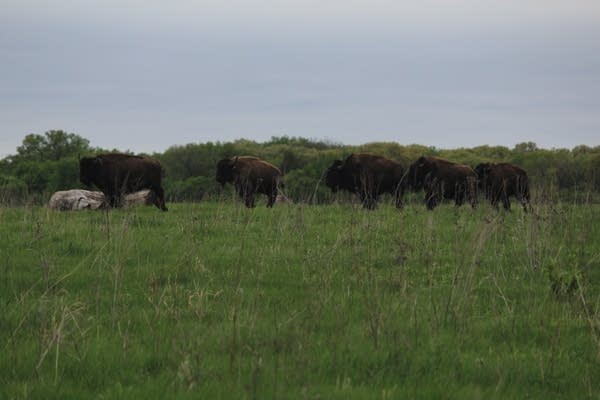A big, hairy solution to restoring Minnesota's prairies

Go Deeper.
Create an account or log in to save stories.
Like this?
Thanks for liking this story! We have added it to a list of your favorite stories.
Bison, which roamed Minnesota in great numbers before the mass destruction of prairie land more than a century ago, have found a new purpose at a nature conservancy near the Twin Cities.
A herd of the massive mammals was released Saturday and will spend the next five months on a 170-acre swath of restored prairie at the Belwin Conservancy in Afton, Minn., where their very presence benefits the landscape.
Belwin executive director Katie Bloome said bison are helpful to the prairie for many reasons. For example, their weight and hooves aerate the soil. Their fur picks up seeds of native plants and spreads them around. They eat invasive species like sweet clover.

Even depressions in the land created by bison wallowing helps, Bloome said. The depressions fill with rainwater and create small ponds from which rodents, birds and insects can find hydration in the dry prairie habitat.
Turn Up Your Support
MPR News helps you turn down the noise and build shared understanding. Turn up your support for this public resource and keep trusted journalism accessible to all.
Minnesota once had 18 million acres of prairie land, according to the Department of Natural Resources. Just a little more than 1 percent of that native prairie remains today.
Preserving and restoring prairie land is critical for Minnesota, Bloome said. The prairie at Belwin used to be farmland, and has since been converted back to tallgrass prairie.

She noted that prairies help filter water and promote species diversity.
"We have on our prairie several species that are threatened or endangered. We've seen rusty patched bumblebee at Belwin, we've seen Henslow's sparrow nesting here, and those are species that are under threat of going away," she said. Prairie land "actually promotes that species diversity and provides a habitat that they need."
The Belwin herd came from Northstar Bison farm near Rice Lake, Wis., on two trailers on Saturday afternoon. This is the 11th year the conservancy has hosted bison.
These animals will become food once they're bigger. Belwin staff didn't shy away from that fact, despite the crowds of people who came to the conservancy Saturday to marvel at the animals.
For Northstar and Belwin, the bison are part of a sustainable meat production cycle.

Northstar ranch manager Marielle Hewitt said the farm is careful to ensure the sustainability of each part of its operation.
"Our mission with what we do with our land is to use bison to regenerate native prairie and native grasses to the Midwest," Hewitt said. "And meanwhile, we try to have a sustainable regenerative style all throughout our ranching into our processing facility and all the way to the customer."
If you go
People who want to see the bison on the prairie can view them at Belwin throught the summer. The conservancy is open dawn to dusk every day. More information and directions are available on Belwin's website.
Correction (May 19, 2019): An earlier version of this story contained some incorrect references to the name of Belwin Conservancy.



